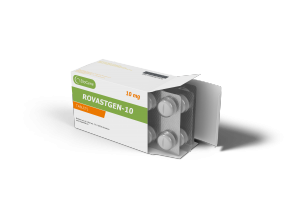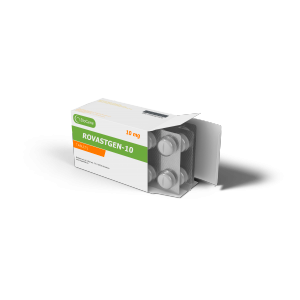
Trade name
Rovastgen
Drug description
White or yellowish-white tablets, almost rectangular, with break line.
Main Active Ingredient
Rosuvastatine
Pharmaceutical form:
Tablets
DRUG CLASS AND MECHANISM:
Rosuvastatin is an oral drug for lowering blood cholesterol levels. It belongs to a class of drugs called HMG-CoA reductase inhibitors, more commonly referred to as “statins”. Other drugs in this class include simvastatin (Zocor), lovastatin (Mevacor), pravastatin (Pravachol), atorvastatin (Lipitor) and fluvastatin (Lescol). These drugs reduce cholesterol levels by inhibiting HMG-CoA reductase, an enzyme that produces cholesterol in the liver. Rosuvastatin and other statins lower blood total cholesterol as well as blood LDL cholesterol levels. LDL cholesterol is the “bad” type of cholesterol that increases the risk of coronary artery disease (atherosclerosis) and heart attacks. Lowering LDL cholesterol levels slows the progression of coronary artery disease and may even reverse it. Statins also increase HDL cholesterol, the “good” type of cholesterol, and reduce triglycerides.
Scientists have discovered that in addition to atherosclerosis, inflammation of the coronary arteries may also contribute to the development of heart attacks. The presence of inflammation can be determined by measuring a chemical in the blood called highly sensitive C-reactive protein (Hs-CRP). Moreover, Hs-CRP can be used to predict the occurrence of heart attacks, strokes and death. Hs-CRP is, in fact, a better predictor of the risk for heart attacks than LDL cholesterol. Scientists have found that statins reduce the level of Hs-CRP in the body, presumably by reducing inflammation in the coronary arteries, and this may be another mechanism through which statins prevent heart attacks, strokes, and death. More research needs to be conducted, however, to confirm the importance of inflammation and the mechanisms through which statins work.
PRESCRIBED FOR:
Rosuvastatin is used for the reduction of blood total cholesterol, HDL cholesterol and triglyceride levels, and to increase HDL cholesterol levels.
Rosuvastatin also is used for reducing the risk of heart attacks, stroke, and arterial revascularization procedures in patients without clinically evident coronary heart disease but with multiple risk factors.
DOSING:
The starting dose for most adults is 5 mg once daily. The maximum dose is 40 mg daily, and this dose should be reserved for patients who do not adequately respond to a 20 mg dose.
DRUG INTERACTIONS:
When administered with cyclosporine, the blood level of rosuvastatin increases seven fold, and this could increase the side effects of rosuvastatin.
Rosuvastatin increases the action of the blood thinner warfarin (Coumadin) and could increase the risk of bleeding from warfarin. Antacids reduce the absorption of rosuvastatin and should be administered two hours after rosuvastatin. The use of rosuvastatin with nicotinic acid, gemfibrozil or other drugs that may cause liver or muscle injury may increase the incidence of the muscle injury.
PREGNANCY:
Statins should not be used by pregnant women because there is a high risk of harm to the fetus.
NURSING MOTHERS:
There is no information on whether rosuvastatin is excreted in breast milk.
SIDE EFFECTS:
The most common side effects of rosuvastatin are headache, nausea, vomiting, diarrhea and muscle pain. The most serious side effects are liver failure, muscle breakdown (rhabdomyolysis) and kidney failure. Liver failure caused by statins is very rare. More often, statins cause increases in liver tests due to injury to the liver. The test levels usually return to normal with continued therapy, but if the level is over three times the upper limit of normal or baseline, practitioners usually stop the statin. Periodic measurement of liver tests is recommended for all statins. For rosuvastatin, these tests should be obtained before therapy is started, twelve weeks after therapy is started, when the dose is increased, if there is a medical concern, and periodically during prolonged treatment.
Rhabdomyolysis is a very rare but serious side effect of statin therapy. When used alone the frequency of rhabdomyolysis due to statins is less than one percent. Rhabdomyolysis is a process in which there is severe injury to muscles leading to severe pain and the release of muscle protein (myoglobin) into the blood. Myoglobin may cause kidney failure. To prevent the occurrence of rhabdomyolysis, patients taking statins who develop unexplained muscle pain, weakness, or tenderness should report the symptoms to their health care practitioner. Rosuvastatin may cause reversible increases in the amount of protein excreted by the kidneys, and in some patients kidney failure has occurred as a result. This effect depends on the dose and occurs more often at the 40 mg dose.
USES:
Rosuvastatin is used along with a proper diet to help lower “bad” cholesterol and fats (such as LDL, triglycerides) and raise “good” cholesterol (HDL) in the blood. It belongs to a group of drugs known as “statins.” It works by reducing the amount of cholesterol made by the liver. Lowering “bad” cholesterol and triglycerides and raising “good” cholesterol decreases the risk of heart disease and helps to prevent strokes and heart attacks.In addition to eating a proper diet (such as a low cholesterol/low-fat diet), other lifestyle changes that may help this medication work better include exercising, losing weight if overweight, and stopping smoking. Talk with your doctor for more details.
HOW TO USE:
Read the Patient Information Leaflet if available from your pharmacist before you start taking rosuvastatin and each time you get a refill. If you have any questions, ask your doctor or pharmacist.Take this medication by mouth with or without food as directed by your doctor, usually once daily.Dosage is based on your medical condition, response to treatment, age, and other medications you may be taking. Be sure to tell your doctor and pharmacist about all the products you use (including prescription drugs, nonprescription drugs, and herbal products).Antacids can reduce the absorption of this drug. Therefore, if taking antacids, take them at least 2 hours after this medication.Take this medication regularly in order to get the most benefit from it. Remember to take it at the same time each day. It is important to continue taking this medication even if you feel well. Most people with high cholesterol or triglycerides do not feel sick.It is very important to continue to follow your doctor’s advice about diet and exercise. It may take up to 4 weeks before you get the full benefit of this drug.
SIDE EFFECTS:
Remember that your doctor has prescribed this medication because he or she has judged that the benefit to you is greater than the risk of side effects. Many people using this medication do not have serious side effects.Tell your doctor right away if this unlikely but serious side effect occurs: foamy urine.This drug may infrequently cause muscle problems (which can rarely lead to a very serious condition called rhabdomyolysis). Tell your doctor right away if you develop any of these symptoms: muscle pain/tenderness/weakness (especially with fever or unusual tiredness), change in the amount of urine.This medication may rarely cause liver problems. If you notice any of the following rare but serious side effects, tell your doctor right away: yellowing eyes/skin, dark urine, severe stomach/abdominal pain, persistent nausea/vomiting.A very serious allergic reaction to this drug is rare. However, get medical help right away if you notice any symptoms of a serious allergic reaction, including: rash, itching/swelling (especially of the face/tongue/throat), dizziness, trouble breathing.This is not a complete list of possible side effects.
Shelf Life
3 years. Do not use after the expiry date.
Special Precautions For Storage
Store in the original package, in a dry, dark place, away from the reach of the children, at a temperature not exceeding 25°C.
